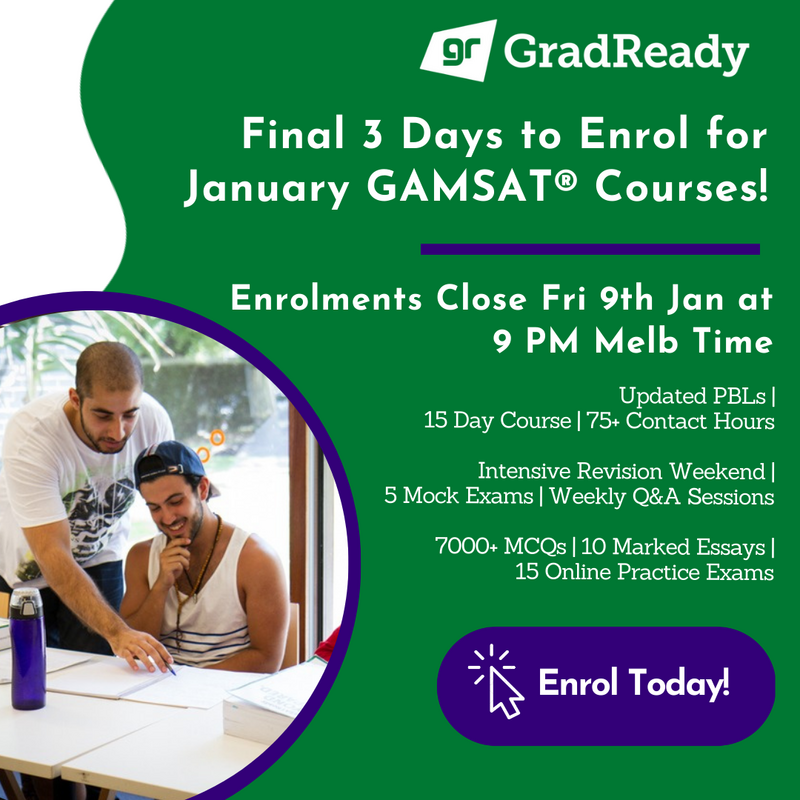For those hoping to start the exciting journey that is medical school, other than preparing for the GAMSAT exam, it’s often quite difficult to get an idea of the general format, and time commitment, that will be required of you. Here I'll go through what a typical week might look like for your average medical student.
We covered the basics of How to Become a Doctor in Australia in our other blog article. Additionally, people often ask whether they’ll be able to work part-time, or if they’ll have the time to play sport on weekends and attend training on weekday evenings etc. The general answer to this is, it’s up to you. The more helpful answer is, probably yes. To summarise, while you can consider medical school as similar to a full-time job as far as the overall time requirement is concerned, most people can still manage to work 5-10 hours per week around this, if not more. If you currently do bar work a couple of nights a week from 8-12, there’s no reason at all that this wouldn’t be possible through the first couple of years of medical school. If you stand behind the counter at a petrol station for 8 hours straight on a Saturday, don’t let your secret life as a budding medical professional stand in your way. By the way, this blog mainly applies to the ‘pre-clinical’ years of medical school (i.e. first and second year). The 3rd and 4th year, which are the clinical years and are more hospital based, are another kettle of fish entirely.
For some background, I’m currently about half way through second year at Flinders, but most Australian graduate schools follow a similar format. At Flinders, teaching is separated into three subjects. Knowledge of Health and Illness (KHI) is the major subject that covers your ‘book learning’, and tends to have the major exams each semester. Doctor and Patient (D&P) is where you learn clinical examination and history taking skills. It’s generally assessed throughout the semester, with interviews and examinations carried out on actors, as well as assignments that require you to visit the wards and interview real patients. Then there’s Health Professions and Society (HPS), which is a bit of a mish mash of everything else they’d like to teach you (epidemiology, ethics, law, Indigenous health etc.).
OK, so with the general stuff out of the way, I thought it may be helpful to talk you through what the timetable looks like for a typical med student. I’ve picked what looks like a pretty representative week from my timetable during our neurology teaching block last month.
Monday – 9am lecture on eye anatomy, followed by an anatomy practical on the forebrain from 10-11:30 (or 11:30 to 1:00 for half the year). Then ‘clinical skills’ from 1:00-2:30 where we’re learning neurological assessment. This is done in our PBL groupings of 8, and the tutor is an ED doc. Then 3-5pm is the first of two PBLs (problem based learning) for the week. PBLs are the bread and butter of med student teaching, where you go through cases in small groups and decide what you need to learn.
Tuesday – Three hours of lectures from 10am. The first two on visual pathways, and the third on psychiatric risk-assessments (a carry-over from previous weeks). Dissection from 2-5pm. This is an ongoing dissection since second semester of first year. 10 people per cadaver and there’s a weekly session to discuss the weeks work, and then you come in in pairs to complete it during the week.
Wednesday – ‘psychobehavioural tutorial’ from 10-12. In our PBL groupings again. This is a six week component where we learn behavioural change techniques and practice them on a willing volunteer, reporting back to the group each Wednesday morning. Then there’s a practical (vision testing) from 3-5.
Thursday – The second PBL from 11-1, and then nothing else scheduled (for me at least – see ‘extras’ below).
Friday – 9-11 is expert review session. This is where an expert in the field goes through the week’s PBL in detail, answering any questions, and giving gems of information from their clinical experience. Then there’s two hours of HPS lectures (currently on ethics) from 11am, and an ‘intro to next week’ lecture from 2-3.
So if my maths is right, the above works out to about 23 contact hours. Not a walk in the park, but also not the crazy schedule you might have imagined? Well here’s a few other things to bear in mind.
Extras – throughout the semester, there are various other requirements that are ‘off-timetable’. For example, each person has 1-2 hours (sometimes more) of dissection to carry out each week. This semester, we’re also scheduled for sessions on rectal examination, breast examination, and a combined cardio-respiratory assessment. So any one of those may fill a gap in the timetable. During the semester, we need to carry out four patient interviews and write up the reports, so sometimes a ‘free’ afternoon will be spent venturing into the wards to find patients to interview. And then of course there’s PBL study. Each Monday, you need to have a general idea of what the week is about, and come ready to contribute to discussions about the case. After the first PBL, you’ll have a list of learning objectives to work through before the second session, and this could take you many hours to cover. And although these aren’t assignments, unless you want to really annoy seven of your class mates by being completely useless in PBL, then you really need to keep on top of things. And then of course there are assignments. Some course units have weekly quizzes, while others (particularly in HPS) have essays or other assignments. Sometimes the clinical skills session will be an assessment with a standardized patient (known as an SP), which you’ll need to watch a recording of and then write up a self-assessment, as well as the case report.
Does that sound a bit more challenging now?
So there you have it. A snapshot of what might be in store for you in the next year or two. It’s busy, and challenging, but definitely manageable. From my own experience from undergrad, the major difference is that there’s absolutely no room to slack off here. I recall weeks in my bachelor degree where I had only 10-12 contact hours, and I could probably miss half of those without anyone caring - grab the notes from a buddy, and generally forget about it until swotvac. That just won’t cut it in medicine. There’s so much material that you need to stay on the ball. Do that, and you’ll be fine.
Hope I haven’t scared you off! To learn more about how to get into medical school, check out our guide on Australian Graduate Medical Schools - Admission Requirements.






